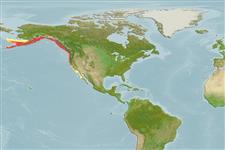Common names from other countries
Classification / Names / Names
俗名 | 同种异名 | Catalog of Fishes (gen., sp.) | ITIS | CoL | WoRMS
Environment: milieu / climate zone / depth range / distribution range
生态学
; 半咸淡水; 深度上下限 0 - 360 m (Ref. 865). 3°C - 19°C (Ref. 104779), preferred 9°C (Ref. 107945); 61°N - 23°N, 179°W - 110°W
分布
国家 | FAO区域 | 生态系 | 标本纪录 | 简介
Eastern Pacific: Aleutian Islands, Alaska to Magdalena Bay, Mexico. Subtropical to boreal.
Length at first maturity / 大小 / 重量 / 年龄
Maturity: Lm ?, range 10 - ? cm Max length : 22.5 cm CW 雄鱼/尚未辨别雌雄; (Ref. 865); 16 cm CW (female); 最大年龄: 10 年 (Ref. 104779)
Maximum length for females from Ref. 104779. Epibenthic in estuaries and nearshore environments (Ref. 104211). It is found on soft bottoms in very low intertidal areas to a depth of 360 meters (Ref. 865). Found on seagrasses (Refs. 104216, 106869). Juveniles inhabit and forage on estuaries, particularly in oyster reefs, oyster beds (Ref. 104211, 113901), and eelgrass (Ref. 104211).
Life cycle and mating behavior
成熟度 | 繁殖 | 产卵场 | 卵 | 孕卵数 | 仔鱼
Life cycle: The fertilized egg hatches into prezoeae larva and molts into zoea an hour after. The larvae undergo five zoeal stages before molting into megalopae. The megalopae molts into juvenile stage before further molting (at most 12 times) into adult stage (Ref. 104779). Mating behavior: Precopulatory courtship ritual is common (through olfactory and tactile cues); usually indirect sperm transfer (Ref. 833). Males locate premolt females through a pheremonal homing system. Male holds the female in an embrace for at most 7 days prior to the female's molting. An hour after molting, copulation occurs through insertion of male gonopods into the spermathecae of the female to deposit sperm (indirect sperm transfer). The female may then be embraced again for 2 days. Pre- and post-mating embraces are done to protect females from predation, aside from insuring mating success. Mating occurs in estuaries but spawning takes place offshore (Ref. 104779). Crabs can store and utilize sperm for at least 2 years. Eggs are fertilized as they pass through the spermathecae during extrusion (Ref. 104787).
主要参考文献
参考文献 | 合作者 | 合作者
Shirley, S.M., T.C. Shirley and S.D. Rice. 1987. (Ref. 8391)
世界自然保护联盟红皮书 (Ref. 130435)
Not Evaluated
Not Evaluated
人类利用
渔业: 商业性
FAO - 渔业: landings, 物种外形 | FishSource | 周边海洋
工具
网络资源
Estimates based on models
Preferred temperature
(Ref.
115969): 5.8 - 9.8, mean 7.8 (based on 87 cells).
Prior r = 0.57, 95% CL = 0.37 - 0.85, Based on 3 data-limited stock assessments.
